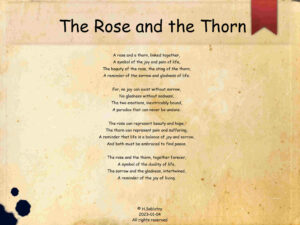Literal Meaning
The theme of the poem is the intertwining of sadness and joy, two seemingly incompatible feelings.
Story
The poem describes how a rose and a thorn are connected, with the rose standing in for joy and the thorn for sadness. It considers how the two feelings may coexist, how they can both be experienced simultaneously, and how one cannot be sensed without the other.
Mood:
As it acknowledges the difficulties of life and the joy that may be found in accepting both grief and delight, the poem creates a melancholy yet hopeful attitude.
Metaphorical Meanings:
The relationship between joy and sadness in life is represented by the rose and the thorn. The thorn is a symbol of sorrow and suffering, while the rose is a symbol of beauty and hope. The poem also conveys the notion that, in order to attain peace, joy and grief must coexist in equal measure throughout life. The poem is further developed to examine the notion that one emotion’s appreciation can only be achieved through going through its polar opposite. In other words, only after experiencing both joy and grief can one completely grasp both.
Content and structure
The poem investigates the duality of existence and the connection between joy and sadness.
It opens by explaining the relationship between the metaphors of the rose and the thorn.
The concept that the two emotions may coexist and that one cannot be felt in the absence of the other is then explored.
Additionally, it compares the two, showing how closely related they are—the beauty of the rose and the misery of the thorn.
The poem’s final line reflects on the idea that, in order to find peace, joy and sorrow must both be accepted in life. It is written in the style of a sonnet, with the first eight lines concentrating on the metaphor of the rose and the thorn and the final six lines exploring the deeper meanings of the metaphor. The poem also employs literary methods to communicate its atmosphere and meaning, including imagery, metaphor, and personification.


That’s really true:)